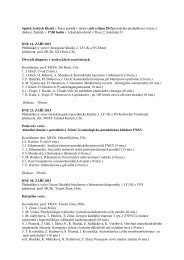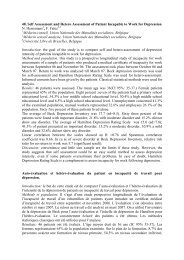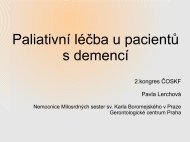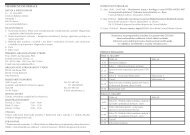ABSTRACTS â ORAL PRESENTATIONS - AMCA, spol. s r.o.
ABSTRACTS â ORAL PRESENTATIONS - AMCA, spol. s r.o.
ABSTRACTS â ORAL PRESENTATIONS - AMCA, spol. s r.o.
You also want an ePaper? Increase the reach of your titles
YUMPU automatically turns print PDFs into web optimized ePapers that Google loves.
66. DNA REPAIR STUDIES IN LIVING CELLS BY THE USE OF CONFOCAL MICROSCOPY<br />
Eva Bártová, Soňa Legartová, Petra Sehnalová, Lenka Stixová, Stanislav Kozubek<br />
Institute of Biophysics, Academy of Science of Czech Republic, v.v.i., Brno, Czech Republic;<br />
bartova@ibp.cz<br />
The maintenance of genome integrity is fundamental for proper cellular functions.<br />
Genomes are continuously exposed to genotoxic injuries, including UV irradiation<br />
and oxidative stress caused by pollutants. Thus, starting an appropriate DNA repair<br />
signaling pathway is more than demanding for genome stability. Genotoxic stress<br />
generally leads to induction of strand breaks in DNA and especially double-stranded<br />
breaks are dangerous in terms of their faulty repair. The result of inappropriate DNA<br />
repair is the emergence of mutations or chromosomal translocations leading to cancer<br />
progression. Thus, here, we tried to address the function of epigenetic factors, including<br />
histone acetylation, phosphorylation and methylation during DNA damage response. In<br />
addition, in living cells, we analyzed histone code-related proteins and their functional<br />
properties in relationship to optimal DNA repair. In tumor cells, we found acetylationdependent<br />
recruitment of BMI1 and HP1β proteins into locally induced DNA lesions.<br />
Moreover, appearance of Polycomb group-related BMI1 protein and heterochromatin<br />
protein HP1β to DNA lesions was ATPdependent. Changes in histone acetylation and<br />
phosphorylation of H2AX, we also studied in embryonic stem cells, characterized by<br />
acetylation-dependent recruitment of OCT4 protein to DNA lesions, induced in living<br />
cells by local micro-irradiation. Besides OCT4, transcription factors UBFs were recruited<br />
to DNA lesions induced in both nucleoli and non-nucleolar compartment of interphase<br />
nuclei. These experiments showed us a new direction of how to study the fate of<br />
transcription factors after micro-irradiation of living cells.<br />
Acknowledgements<br />
Work was supported by Grant Agency of the Czech Republic, project No.: 13-07822S<br />
and by national COST-CZ project No.: LD11020.<br />
67. INTRODUCTION TO AUTOMATED MICROSCOPY FOR HIGH-THROUGHPUT AND<br />
HIGH-CONTENT SCREENING<br />
Eva Vesela 1 , Tomas Furst 2 , Lenka Radova 3 and Martin Mistrik 1<br />
1<br />
Laboratory of Integrity of Genome, Institute of Molecular and Translational Medicine,<br />
Palacky University, Olomouc, Czech Republic; eva.vesela@upol.cz<br />
2<br />
Department of Matematical Analysis and Math Apllications, Faculty of Science, Palacky<br />
University,Olomouc, Czech Republic<br />
3<br />
Laboratory of Experimental Medicine, Institute of Molecular and Translational<br />
Medicine, Palacky University, Olomouc, Czech Republic<br />
Microscopy-based readout provides the most detailed single cell evaluation. Recent<br />
Analytical Cytometry VII 83








